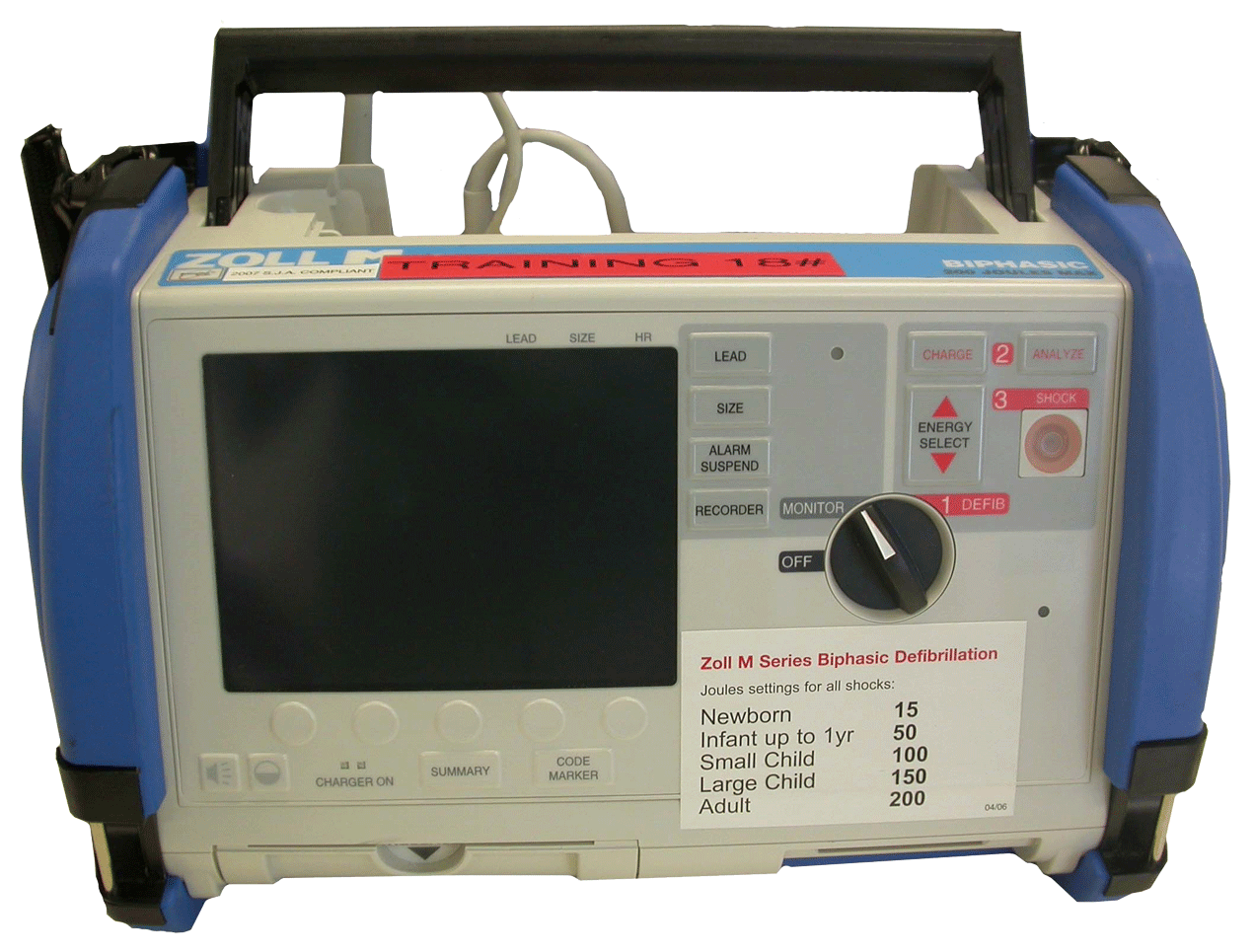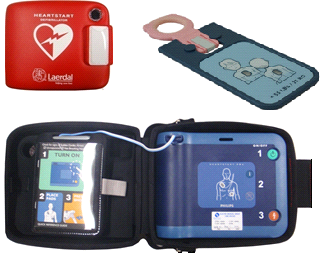
Familiarity with the device being used is essential.
This is not intended to be a specific instruction guide.
- To analyse electrical activity of the heart.
- Provide a direct current electrical shock (defibrillation) for shockable rhythms.
- Do not defibrillate over a medication patch or pacemaker site.
- Do not use the device in direct presence of possible ignition sources e.g. flammable vapors, and/or explosive materials.
- Do not place pads over ECG dots (remove the dots to ensure pads are in correct position).
- Ensure patient is dry and on a non-conductive surface.
- Ensure there is no person in contact with the patient when delivering a shock.
- Loose pads may cause burned skin or arcing.
- Due to vibrations, consider the possibility of misinterpretation by the device in a moving vehicle and if in doubt, stop and reassess the rhythm.
- All relevant infection control methods to be utilised.
- If patient is found to be non-responsive and pulseless commence CPR as per Cardiac Arrest guidelines immediately.
- Ensure correct placement of the defibrillation pads for adults[1] and paediatrics/infants[2], but DO NOT interrupt CPR to do so.
Adult Pad Placement

Paediatric Pad Placement
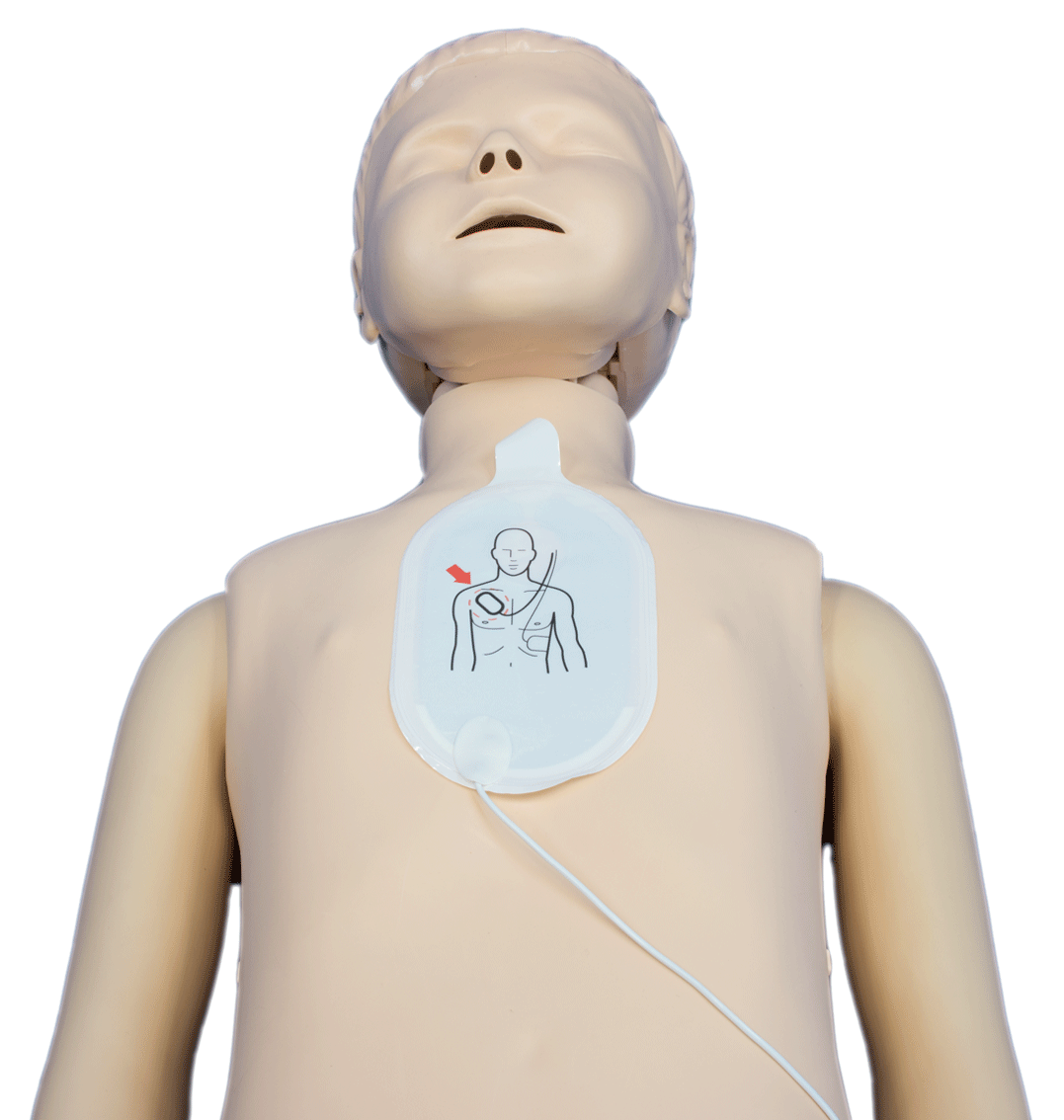

Manual Mode
- Select the appropriate pads for the patient
- For children 6 years and under or less than 20kg: paediatric pads
- For children over 6 years, patients over 20kg and adults (including elderly): adult pads
- Apply the pads to patient’s bare, dry chest as shown on the packaging.
- Select the desired energy setting.
- Charging:
- Announce "Charging to [X] joules, continue compressions".
- Charge the defibrillator and continue compressions.
- At this time warn, and ensure others are CLEAR.
- Once charged, an audible alarm will sound.
- Operator and Compressor must communicate clearly and unambiguously.
- Using a tactile hand tap, announce "STOP Compressions". Compressor must stop and hover.
- Shocking:
- Both Operator and Compressor should assess rhythm; "Confirm shockable / non-shockable".
- If shockable, deliver shock.
- If non-shockable, disarm the device.
- Using a tactile hand tap, announce "Resume Compressions".
- Continue CPR as necessary & assess rhythm every 2 minutes.
NB: Tactile hand taps are an important and necessary safety feature to minimise risk of accidental shock to rescuers and is a MANDATORY component of IMPACT CPR.
Corpuls
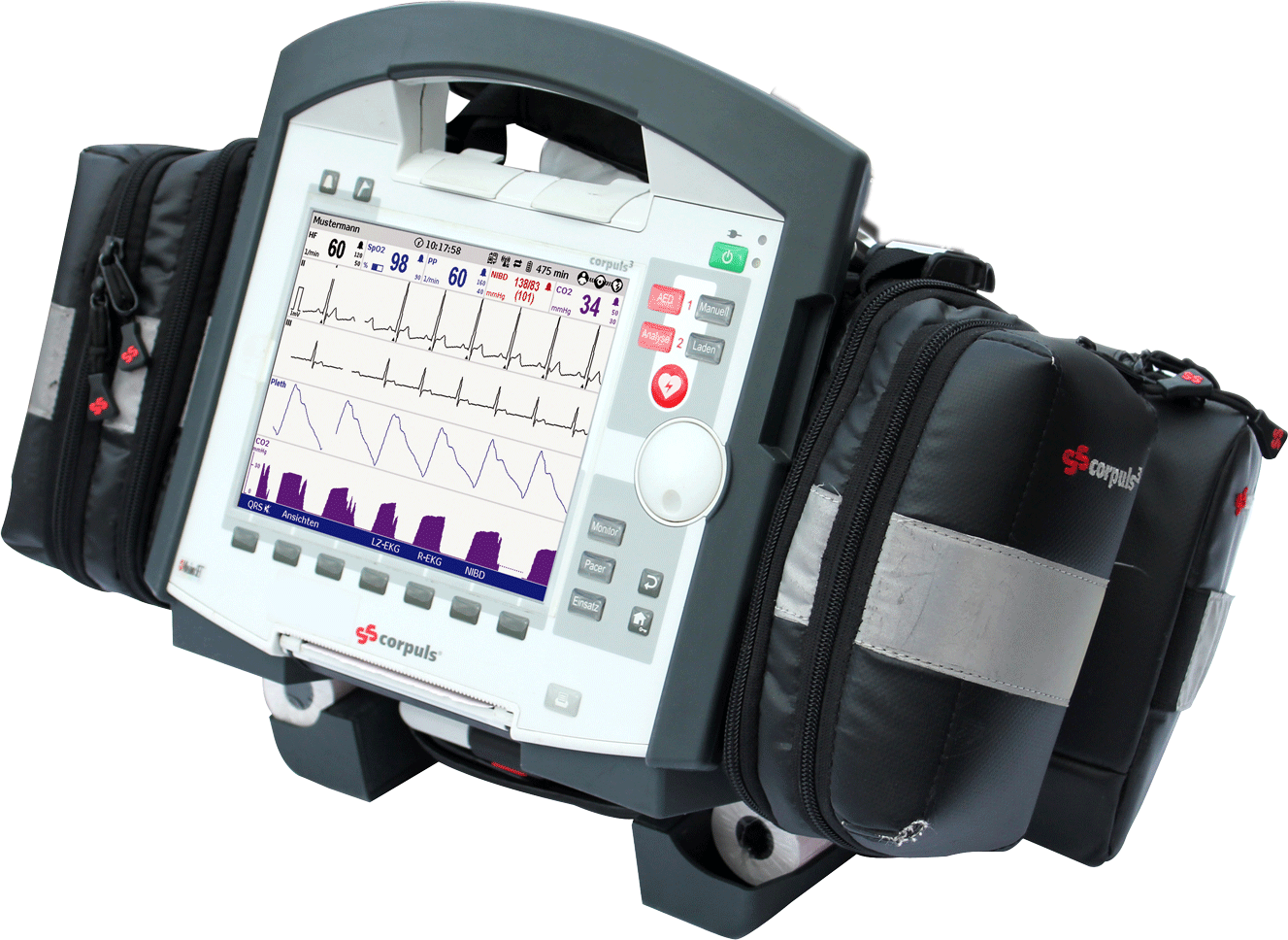
Automatic Mode (Zoll / FR3 / FRx)
- To initiate Automatic mode:
- If using Corpuls, select AED mode.
- If using the Zoll, select "Defib" mode on the dial, and then press "Anaylse".
- If using the FR3 AED, simply open the case and it will automatically turn the unit on. If it does not turn on immediately, press the green power button on the unit.
- If using the FRx AED, open the case and turn on the unit by pressing the green power button.
- If using the FRx/FR3 AED on an infant/child under weight of 25kg or < 8 years insert the infant/child key immediately.
- When using in Automated External Defibrillator (AED) mode ensure the audio and visual instructions are followed. Devices will analyse rhythms automatically.
- When the device prompts so, warn and ensure others are CLEAR.
- One officer may support this by using a tactile hand tap, announcing "STOP Compressions". Compressor must stop and hover.
- If shockable, the unit will emit a beep when fully charged. If shockable, the device will prompt a shock to be delivered.
- After the shock is delivered, using a tactile hand tap, announce "Resume Compressions"; the compressor must resume.
- Continue to follow the prompts, and CPR, as appropriate.
- Patients in shock-refractory VF/VT (>3 shocks) can benefit from a change in electrical vector to assist in terminating the rhythm
- To be considered shock-refractory there must be no termination of the shockable rhythm between shocks
Defibrillation pad placement – Vector Change
- Keeping the original pads in situ, place a second set of defibrillation pads in anterior/posterior (AP) position - as shown with pads 2A and 2B on the diagram.
- Label both sets of leads - A/L for the standard (Antero-Lateral) placement, and A/P for the new (Anterior/Posterior) placement.
- Change to the AP pad cord on the monitor
- Continue as normal with IMPACT resuscitation, using the AP pad placement for further defibrillation attempts
Double Sequential Defibrillation
Double sequential defibrillation (DSED) is the instance of two sequential (<1 second apart) shocks using two sets of pads and two monitors with the pads in the anterior/lateral and anterior/posterior placement. One person who is trained and authorised must discharge both defibrillators sequentially.
- Connect one Corpuls3 monitor to each set of pads (AL and AP placement), ensuring it is known which monitor is connected to which pads.
- Charge both monitors as normal for a status check.
- Defibrillator operator to perform tactile hand tap and announce"stop compressions" as above prior to rhythm check
- If non-shockable, disarm charge on both monitors
- If shockable, deliver shock from both monitors, first using AL pads followed by AP.
- Announce "continue compressions" with tactile hand tap.
Safety considerations:
- Simultaneous defibrillation from both monitors may cause damage to the monitors and has unknown patient effect.
- Unfamiliarity with using two monitors may lead to accidental shocks if another clinician resumes compressions too early.
- Tactile hand-taps are mandatory.
- One clinician should perform hand-tap to stop compressions, defibrillate with both monitors, and perform second hand-tap to resume compressions using the same hand to ensure the correct sequence is followed.
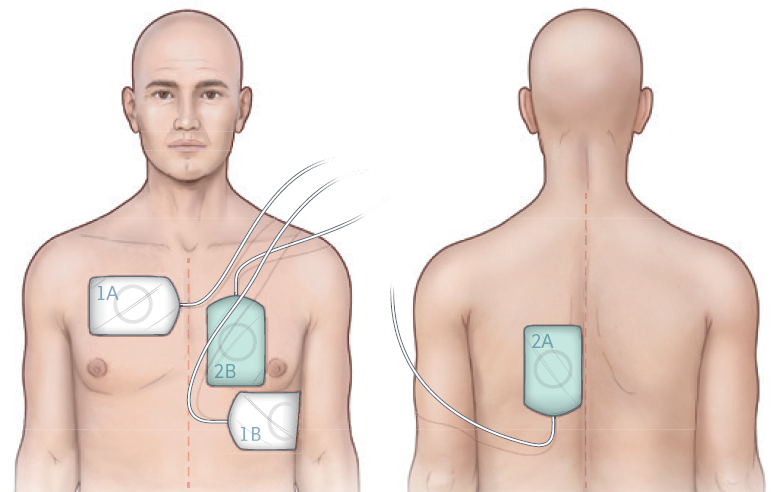
Defibrilator pad placement:
1A/1B: Antero-lateral (standard) placement
2A/2B: Antero-posterior placement
| Settings | |
|---|---|
| Extended Care: | |
| Colour assist: | |
Document Control
Clinical Resources Website
St John Ambulance Western Australia Ltd (ABN 55 028 468 715) (St John WA) operates ambulance and other pre-hospital clinical services. St John WA’s Clinical Resources, including its Clinical Practice Guidelines (Clinical Resources), are intended for use by credentialed St John WA staff and volunteers when providing clinical care to patients for or on behalf of St John WA, within the St John WA Clinical Governance Framework, and only to the extent of the clinician’s authority to practice.
Other users – Terms of Use
The content of the St John WA Clinical Resources is provided for information purposes only and is not intended to serve as health, medical or treatment advice. Any user of this website agrees to be bound by these Terms of Use in their use of the Clinical Resources.
St John WA does not represent or warrant (whether express, implied, statutory, or otherwise) that the content of the Clinical Resources is accurate, reliable, up-to-date, complete or that the information contained is suitable for your needs or for any particular purpose. You are responsible for assessing whether the information is accurate, reliable, up-to-date, authentic, relevant, or complete and where appropriate, seek independent professional advice.
St John WA expressly prohibits use of these Clinical Resources to guide clinical care of patients by organisations external to St John WA, except where these organisations have been directly engaged by St John WA to provide services. Any use of the Clinical Resources, with St John WA approval, must attribute St John WA as the creator of the Clinical Resources and include the copyright notice and (where reasonably practicable) provide a URL/hyperlink to the St John WA Clinical Resources website.
No permission or licence is granted to reproduce, make commercial use of, adapt, modify or create derivative works from these Clinical Resources. For permissions beyond the scope of these Terms of Use, including a commercial licence, please contact medservices@stjohnambulance.com.au
Where links are provided to resources on external websites, St John WA:
- Gives no assurances about the quality, accuracy or relevance of material on any linked site;
- Accepts no legal responsibility regarding the accuracy and reliability of external material; and
- Does not endorse any material, associated organisation, product or service on other sites.
Your use of any external website is governed by the terms of that website, including any authorisation, requirement or licence for use of the material on that website.
To the maximum extent permitted by law, St John WA excludes liability (including liability in negligence) for any direct, special, indirect, incidental, consequential, punitive, exemplary or other loss, cost, damage or expense arising out of, or in connection with, use or reliance on the Clinical Resources (including without limitation any interference with or damage to a user’s computer, device, software or data occurring in connection with such use).
Cookies
Please read this cookie policy carefully before using Clinical Resources from St John WA.
The cookies used on this site are small and completely anonymous pieces of information and are stored on your computer or mobile device. The data that the cookies contain identify your user preferences (such as your preferred text size, scope / skill level preference and Colour Assist mode, among other user settings) so that they can be recalled the next time that you visit a page within Clinical Resources. These cookies are necessary to offer you the best and most efficient possible experience when accessing and navigating through our website and using its features. These cookies do not collect or send analytical information back to St John WA.
Clinical Resources does integrate with Google Analytics and any cookies associated with this service enable us (and third-party services) to collect aggregated data for statistical purposes on how our visitors use this website. These cookies do not contain personal information such as names and email addresses and are used to help us improve your user experience of the website.
If you want to restrict or block the cookies that are set by our website, you can do so through your browser setting. Alternatively, you can visit www.internetcookies.com, which contains comprehensive information on how to do this on a wide variety of browsers and devices. You will find general information about cookies and details on how to delete cookies from your device. If you have any questions about this policy or our use of cookies, please contact us.
